 Planets Planets
 Mars Mars
 General features General features
 Mariner 9 Mariner 9
 Surface features Surface features
 Atmosphere and Interior Atmosphere and Interior
 Viking: Search for Life Viking: Search for Life
 The moons The moons
|
|
| |
The planet Mars |
| |
 Mars,
the "Red Planet", is named after the Roman god of war because it commonly
appears with a reddish tinge when viewed in our sky.
Mars,
the "Red Planet", is named after the Roman god of war because it commonly
appears with a reddish tinge when viewed in our sky.
The adjacent image shows a Viking 2 image of Mars which is still of great interest to us, not the least reason
being that it may once have harbored conditions favorable to the evolution of life.
|
| |
General features |
| |
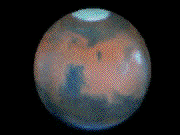 Mars has a rotational period of 24 hours and 37 minutes, a period for
revolution about the sun of 687 days, and a diameter of 6800 km (about half
that of Earth). Its average density is 3.9 g/cc, which is considerably less
than the 5.2-5.5 g/cc characteristic of Mercury, Venus, and the Earth. This
density gives it a mass about 11% of that for Earth.
It is most easily observed from Earth when it is at opposition. Even then, it
was difficult in the past to observe from Earth because of turbulence in the Martian atmosphere and ours.
Mars has a rotational period of 24 hours and 37 minutes, a period for
revolution about the sun of 687 days, and a diameter of 6800 km (about half
that of Earth). Its average density is 3.9 g/cc, which is considerably less
than the 5.2-5.5 g/cc characteristic of Mercury, Venus, and the Earth. This
density gives it a mass about 11% of that for Earth.
It is most easily observed from Earth when it is at opposition. Even then, it
was difficult in the past to observe from Earth because of turbulence in the Martian atmosphere and ours.
The animation to the right shows a sequence of Hubble Space Telescope images
of the Martian surface. The image at the bottom of the page shows several still views from the same source.
Earth based observations concluded that Mars
- Has a reddish hue over 3/5 of the planet, which we now known to be caused by
red dust and rocks on the surface of the planet.
- Has polar ice caps waxing and waning with the seasons that we now know to
be composed both of dry ice (frozen carbon dioxide) and water ice.
- Has surface markings that some originally thought
looked like "canals" from Earth. These are now
known to be features like the edges of mountain ranges.
- Has areas of changing color that were once thought to correspond to
vegetation. We now believe these regions of changing color to be due to
blowing sand, not vegetation.
- Has an atmosphere with clouds.
Increased understanding of Mars had to await the results of space probes,
beginning with Mariner 4, 6, 7, and 9 in the period 1965-1971, and the Viking 1 and 2 probes in 1976.
|
| |
Mariner 9 |
| |
 Mariner 4, 6, 7, were flyby missions that could only photograph small regions
of the Martian surface. They saw portions of the surface that suggested Mars
was drab and cratered like the Moon, and geologically dead. This was changed
profoundly by the orbiter Mariner 9, which went into orbit around Mars in late
1971. When it arrived the entire Martian surface was engulfed in a dust storm
that left almost no surface features visible.
Mariner 4, 6, 7, were flyby missions that could only photograph small regions
of the Martian surface. They saw portions of the surface that suggested Mars
was drab and cratered like the Moon, and geologically dead. This was changed
profoundly by the orbiter Mariner 9, which went into orbit around Mars in late
1971. When it arrived the entire Martian surface was engulfed in a dust storm
that left almost no surface features visible.
When the dust storm finally
subsided in early 1972, Mariner 9 discovered that we had been badly misled by
the earlier flyby missions that had seen only small (in retrospect,
unrepresentative) portions of the surface.
Mariner 9 found evidence for a planet having many
interesting geological features:
- Meteor craters and volcanic plains
(the largest crater is Hellas, which is 2000 km across).
- Huge volcanic cones (the three round
features at the left of the
adjacent image
are volcanic cones).
- Gorges larger than the Grand Canyon here on Earth (the feature in the
center of the adjacent image is a canyon system, Valles Marineris,
that extends over a region the width of the United States).
- Vast sedimentary deposits in the Polar regions.
- Valleys that looked as if they could be water-formed (but these don't
coincide with the "canals" that people erroneously thought they saw from Earth in
earlier times).
No spacecraft in the history of space exploration has more profoundly changed
our view of a planet than Mariner 9.
|
| |
Surface features |
| |
Mars has many interesting geological features on its surface that first became
apparent with Mariner 9, were subsequently studied by the Viking missions, and
many of which now are visible from the Hubble Space Telescope.
Enormous Shield Volcanoes
In the previous section we saw an image of Mars with 3 large volcanoes on the
left limb of the image. The volcanoes on Mars are now extinct, but they
indicate a preceding period of significant Martian volcanism. Such volcanoes are called
shield volcanoes,
because they look like shields. The largest volcano on Mars is not one
of the three shown previously. It is called Olympus Mons, and is illustrated below
(Ref).
 Olympus Mons is 600 km across its base and about 25 km above the surrounding
plain. A perspective model is shown below
Olympus Mons is 600 km across its base and about 25 km above the surrounding
plain. A perspective model is shown below

For reference, the largest shield volcano on the Earth is Mauna Loa, which is
only about 200 km across its base, and the 25 km height of Olympus Mons is about
2 1/2 times the height of Mount Everest. This raises the interesting issue of
why Mars in its past developed a few very large shield volcanoes, while on the
Earth the more normal pattern is for volcanoes to develop in strings of smaller
volcanoes. As we shall see, the answer is thought to lie in plate tectonics.
Absence of Plate Tectonics
There is no evidence on Mars for large-scale
plate tectonics as we find on
Earth. This is believed to be responsible for the different character of
Martian and Terrestrial volcanoes, as illustrated in the following animation.
On the Earth, as crustal plates move over subsurface chambers of molten rock the lava tends to come to the surface in a
line of places, producing strings of
volcanoes
(for example, volcanic island
chains like the Hawaiian Islands). On Mars, with no horizontal motion of
crustal plates the same point in the crust sits over subsurface chambers of molten rock and a few very large volcanoes are built.
Here is a more extensive discussion of
volcanism on Mars.
Large Canyon Systems
 The Martian surface has some large canyon systems. The largest is Valles
Marineris, which extends for about 5000 km, is 500 km wide in the widest
portions, and as much as 6km deep. The adjacent image shows a portion
of the Valles Marineris (the full system is shown in the preceding section).
This enormous system of connecting canyons appears to have been formed mostly
by local tectonic activity (local motion of surface) rather than by erosion,
though as we will discuss below there is some evidence for fluid erosion in
portions of it.
The Martian surface has some large canyon systems. The largest is Valles
Marineris, which extends for about 5000 km, is 500 km wide in the widest
portions, and as much as 6km deep. The adjacent image shows a portion
of the Valles Marineris (the full system is shown in the preceding section).
This enormous system of connecting canyons appears to have been formed mostly
by local tectonic activity (local motion of surface) rather than by erosion,
though as we will discuss below there is some evidence for fluid erosion in
portions of it.
Running Water Erosion
There are channels on Mars as much as 1500 km long and 200 km
wide that appear to
have been cut by running water. Under present atmospheric conditions on Mars
(low pressure), water cannot exist as a free liquid on the surface (it must be
gas or solid). Thus, evidence for water erosion suggests that the Martian
atmosphere may have been more dense in the past. The following two images show
portions of the Martian surface where the erosion patterns have regions that
are very similar to those found for erosion by surface water on the Earth.
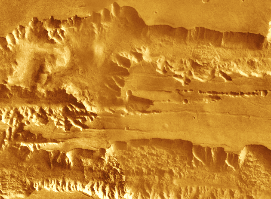 |
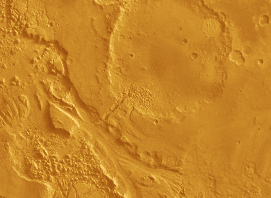 |
| Regions with possible evidence for watererosion on the Martian surface |
Wind Erosion
The atmosphere of Mars is thin (about 1/200 of the pressure of the Earth's
atmosphere), but this atmosphere supports high velocity seasonal winds that are
correlated with solar heating of the surface and that produce duststorms that
lead to a lot of surface erosion. The following image shows a local dust storm
on the Martian surface (lower left).
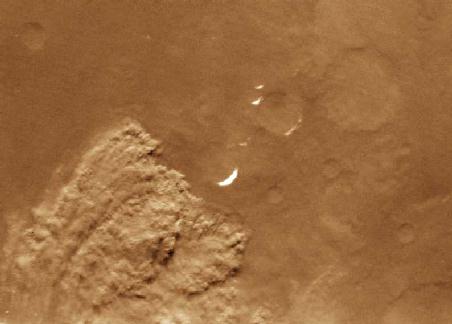 |
| A local dust storm on the Martian Surface
(source) |
Here is
another example of a Martian dust storm.
At times, such local dust storms grow and merge until essentially the entire
surface of the planet is covered by a dust storm. These periods are correlated
with times of maximum solar heating of the Martian surface.
Polar Caps
Mars has polar caps that wax and wane with the Martian seasons.
The following image shows the North Polar Cap.
These polar caps appear to be partially composed of frozen carbon dioxide ("dry ice") and partially composed of frozen water. An
MPEG movie (775 kB) of the rotating Mars animation is also available.
|
| |
Atmosphere and Interior |
| |
The atmosphere and (probably) the interior of Mars differ substantially from
that of the Earth. The atmosphere is much less dense and of different
composition, and it is unlikely that the core is molten.
The Martian Atmosphere
The atmosphere has a pressure at the surface that is only 1/200 that of Earth.
The primary component of the atmosphere is carbon dioxide (95%), with the
remainder mostly nitrogen. Seasonal heating drives strong winds that can
reach 100 mph or more, stirring up large dust storms. Clouds form in the
atmosphere, but liquid water cannot exist at the ambient pressure and
temperature of the Martian surface: water goes directly between solid and
vapor phases without becoming liquid.
 |
| Variation in temperature at the Viking 1 landing site |
The preceding image shows the variation of the surface temperature
over a period of 50 Martian days at the Viking 1 landing site
(data source).
Notice the large variation between night and daytime temperatures (associated
with the low density of the atmosphere) and the almost constant high and low
temperatures for this period. Compare this, for example, with the daily
temperature variations for
Nome,Alaska (note however that the Nome plot is in degrees Fahrenheit, notCelsius).
Here is a graph of Martian atmospheric
temperature variations
as recorded over a period of days at
the Pathfinder (1997) landing site compared with data from the Viking 1 site
over a similar period in 1976 (in the these graphs a
Sol is a Martian day, which corresponds to 24 hours and 37 minutes of Earth time). At the time of these observations,
the night temperatures drop to around -90 degrees celsius, but at the Pathfinder site the day temperature approaches a relatively
balmy -10 degrees celsius at it peak.
The Martian Interior
The density of Mars is about 25% less than that of the Earth, suggesting a
proportionally larger concentration of lighter materials relative to the core.
It is probably intermediate in composition between the Earth and the Moon.
Though Mars is probably at least partially differentiated, there is little
evidence for large-scale tectonic motion (but there is smaller scale motion
such as that responsible for the Valles Marineris system). The core is thought
to be iron sulphide; the absence of any detectable magnetic field even though
the rotation period is comparable to that for Earth suggests that the core is
probably not liquid.
|
| |
Viking: Search for Life |
| |
In 1976 the Viking 1 and 2 landers undertook searches on the Martian
surface for the chemical evidence of present or past life on Mars. The
images shown below give a picture of one of the backup landers, and
two different views of the Martian surface as
photographed from Viking 1.
 |
 | 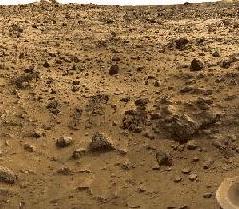 |
| Viking lander
(Ref)
and two views of the Martian surface from Viking 1
(Ref) |
In addition to photgraphing the surface, the Viking landers undertook a series
of experiments at two points on the surface to find evidence for life.
The Experiments
The 4 basic experiments that the Vikings carried out to search for evidence of life
were:
- Gas Metabolism: look for changes in the atmosphere induced by
metabolism in the Martian soil.
- Labeled Release: Look for release of radioactive carbon dioxide by
metabolism from organic material labeled by radioactive carbon.
- Pyrolytic Release: Search for radioactive compounds in soil
by heating soil exposed to radioactive carbon dioxide.
- Mass Spectrometer: Search directly in Martian soil
for organic compounds known to
be essential to Earth life.
These experiments were built around the hypothesis that if there were life on
Mars it would have a similar metabolism to life on Earth, and that it would
have a similar biochemistry based on the same organic compounds important to
life on Earth.
The Results
The results of these experiments were complex. The first three gave positive
results, but the complete absence of any organic compounds in the Martian soil
according to the mass spectrometer experiment suggests that the positive
results for the first three were not evidence for life, but rather evidence for
a complex inorganic chemistry in the Martian soil. Thus, the Viking verdict
was that there was no evidence for present or past life on Mars.
Renewed Interest in Martian Life
This issue has been given renewed impetus by the
recent claim
(see also this
andthis)
that a meteorite
found on the Earth was once part of Mars (because of detailed chemical
composition), and that there may be evidence in this rock for past organic
activity. However, this is a very open topic at the moment, since there
potentially are other explanations of the meteorite's content.
We will have to wait on further evidence to clarify this issue.
The Newest Martian Missions

-
Pathfinder which explored the Martian surface last year.
The image to the left is from Pathfinder on Mars.
-
Mars Global Surveyor: arrived in Martian orbit September 12, 1997.
Here is a summary of its trajectory from Earth to Mars.
|
| |
The moons |
| |
Mars has two small moons that are illustrated in the following figures,
Phobos and Deimos.
These are examples of what are
called minor satellites: small chunks of rock in orbit around planets
as compared with large satellites like the Earth's Moon. As the adjacent
images show, they are very irregular in shape. Phobos is 27 km long in its
longest dimension and Deimos is 15 km long in its longest dimension.
 Both are cratered and orbit the planet in rather low orbits. Phobos is only about 3000
miles above the Martian surface and orbits in a little over 7 hours (thus it
makes more than 3 orbits in a single Martian day). Deimos is a little further out and orbits in about 30 hours.
Both are cratered and orbit the planet in rather low orbits. Phobos is only about 3000
miles above the Martian surface and orbits in a little over 7 hours (thus it
makes more than 3 orbits in a single Martian day). Deimos is a little further out and orbits in about 30 hours.
The figure to the right
(Ref)
shows a rather spectacular image taken by the Viking 2 orbiter from an
altitude of about 8000 miles above the Martian surface. The image
looks down on a Martian shield volcano (Ascraeus Mons) which is about 200 miles
across and in the center. The object down and to the left of the volcano is
Phobos, which is 5000 miles below the orbiter, and 3000 miles above the Martian
surface! (The regular horizontal rows
of dots seen in the image are an artifact associated with the imaging;
they don't correspond to real features.)
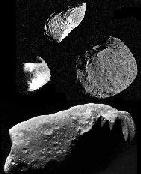 These moons of Mars were not formed in the same way as the Earth's Moon. They
are probably fragments of larger objects broken apart in a collision. Such
moons may be formed from collisions of objects originally in orbit around the
planet, or they might also have been captured gravitationally at some point in
the past. The adjacent image
(Ref)
compares the appearance of several minor satellites of the Solar System
(Phobos, Deimos, Gaspra, and Ida). We shall encounter many such small moons around the giant planets like Jupiter and Saturn.
These moons of Mars were not formed in the same way as the Earth's Moon. They
are probably fragments of larger objects broken apart in a collision. Such
moons may be formed from collisions of objects originally in orbit around the
planet, or they might also have been captured gravitationally at some point in
the past. The adjacent image
(Ref)
compares the appearance of several minor satellites of the Solar System
(Phobos, Deimos, Gaspra, and Ida). We shall encounter many such small moons around the giant planets like Jupiter and Saturn.
|
|


